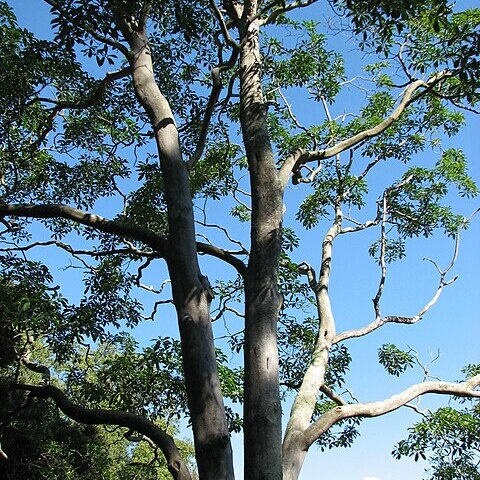Small to medium tree to c. 22 m high and to 45 (–60) cm d.b.h., with a narrow canopy, sometimes deciduous. Bark thickly fissured, dark grey. New shoots villous with uniseriate hairs, rigid, erect with resin, bases persisting, clear. Branches held horizontally or erect. Two cotyledons opposite, thin, narrow elliptic; earliest stages leaf margins very dentate, almost lobed. Adult leaves appearing whorled at the end of branches due to internode suppression; petiole 10–13 mm long; lamina narrowly obovate; (65–) 80–105 (–130) mm long (20–) 30–45 mm wide, margin entire; upper surface glabrous, deep glossy green; lower surface lighter green, with few hairs along midrib only. Inflorescences terminal, lax branched umbels of protandrous hermaphroditic, irregular, very aromatic flowers. Flowers open in male phase with stamens grouped by height (2 + 2+1, as for Marianthus) facing petal break, dehiscing golden pollen, with white-tinged lemon petals. In female phase flowers the petals become yellow with rosy purple track lines appearing in the throat, the stamens then curl out of the way of the developing stigma. Spatial and temporal changes over 5 days are at the level of the inflorescence so at any time all the flowers in that and surrounding inflorescences are at the same sex phase. Flowers with bracts; bracteoles leaf-like, to 6 mm long, caducous. Sepals to 8 mm long, elliptic (ovate in New Guinea), imbricate, not cohering, light green, glabrous. Petals clawed, densely hairy outer surface; floral tube to 20–28 mm long, centrally cohering, apices salverform, recurving 10–12 mm, opening green-cream, eventually canary yellow.Stamens irregularly grouped by unequal lengths, curling, caducous; filaments ⅔ densely hairy, thin, flat, glabrous apically; anthers versatile. Pistil with receptacle disc present; gynophore c. 10 mm long; ovary densely hairy; style glabrous, elongating with maturity; stigma eventually fat bilobed. Fruit bilocularloidally dehiscent capsule; leathery, or pithy, black-brown, stalked (to 10 mm long), then about as wide as long (25–35 mm), densely hairy; seeds inserted on a raised placental ridge, funicles 1–3 mm long, ribbony, fawn. Seeds numerous, inserted in a single row horizontally filling each chamber, reniform to 7 mm long surrounded by a 4 mm wide membranous wing.
More
Evergreen treelet, 6 m. Leaves obovate-oblong to oblanceolate, acute-acuminate, narrow cuneate-decurrent at the base, glabrescent, 7½-15 by 3-4.5 cm; petiole 1-1.5 cm. Corymbs few or many-flowered, tomentose-pubescent; peduncle 3-6 cm, c. 10(-20) by 10 cm. Bracts foliaceous, acute, oblong, 10-15 by 3 mm. Pedicels 3-4 cm. Bracteoles small, linear or lanceolate, acute, c. 10 by 1-2 mm. Flowers scented, yellow or cream tipped yellow, petals suffused with rosa-violet inside at the base (CARR). Sepals oblong-rounded or acutish, 5-6 by 2.5-3 mm, with a thin margin. Petals: claw-like base 2.5 cm, linear, erect, tomentose outside, the spreading lamina rhomboid-ovate, c. 1-1.25 by 0.75 cm, veined, puberulous outside. Stamens pubescent below, glabrous towards the apex; anthers oblong, c. 2 mm, cells at the base for 0.25 mm free, divaricate. Ovary silky-tomentose, terete, c. 1.75 cm; style c. 4-5 mm. Capsule (not seen) stipitate, ± orbicular, compressed, c. 2.5-3 cm diam. Seeds (not seen) c. 4-6 mm long, wing 2-3 mm broad.
Uses. A pretty ornamental, resembling a very large-flowered Pittosporum, grown with success in the Tjibodas Mountain Garden (W. Java) under everwet climatic conditions at c. 1400 m; also cultivated at Bogor, c. 250 m, but not flowering there; also in greenhouses in temperate regions.


